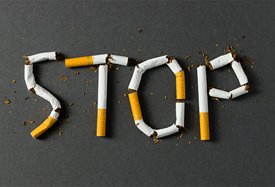 Quitting any habit isn’t easy. When it comes to smoking, quitting can be one of the most difficult actions a person can take—it requires commitment, a strong desire to be smoke-free, and especially, quitting requires a lot of support. This year don’t quit alone, instead join with thousands of other people in the Great American Smokeout and take the first step toward kicking the habit for good.
Quitting any habit isn’t easy. When it comes to smoking, quitting can be one of the most difficult actions a person can take—it requires commitment, a strong desire to be smoke-free, and especially, quitting requires a lot of support. This year don’t quit alone, instead join with thousands of other people in the Great American Smokeout and take the first step toward kicking the habit for good.
What is the Great American Smokeout?
Roughly 34 million American adults still smoke, and while that number represents a significant decline from 42% of Americans in 1965 to 14% in 2019, the current numbers are still too high. In fact, smoking is still the single largest preventable cause of death and illness in the United States, resulting in approximately 480,000 deaths a year (or 1 in 5 deaths worldwide), and costing the global economy nearly 1.85 trillion annually.1
To help reduce the number of Americans still smoking even further, for over 40 years the American Cancer Society has held the Great American Smokeout event on the third Thursday in November (this year on November 18th). The Great American Smokeout provides people who smoke with the opportunity to commit to healthy, smoke-free lives. Importantly, it marks a specific day when that commitment can begin—it says, “my new life begins today”—and it allows for people who smoke to begin the cessation process with the support of family, friends, institutions and other people trying to quit.
Moreover, according to the American Cancer Society, setting a specific and communal day to stop smoking, “provides an opportunity for individuals, community groups, businesses, health care providers, and others to encourage people to use the date to make a plan to quit…and helps people learn about the many tools to help them quit and stay quit.”
Health risks associated with smoking
Nicotine—the psychoactive chemical compound found in tobacco and tobacco products—creates one of the strongest and deadliest addictions anyone can have. If you smoke, or know people who smoke, you understand that quitting tobacco products, like cigarettes, is particularly difficult—you also understand that inhaling smoke on a daily basis comes with a number of health risks. Indeed, smoking can lead to a number of diseases and harms almost every organ system in the body. Some of the diseases caused directly by smoking include:
-
Asthma: is a chronic disease that effects the airways of the lungs. When someone has an asthma attack, the airways swell and narrow, making it hard to breath. Tobacco smoke—even second hand smoke—is a common “trigger” for asthma attacks.
-
Cancer: 90% of lung cancers today are caused by smoking, but smoking can also cause cancer in almost any other part of the body, including: the blood (leukemia), bladder, colon and rectum, esophagus, kidneys and liver.
-
Chronic obstructive pulmonary disease (COPD): refers to a group of diseases that cause airflow blockage and breathing related problems. Examples include emphysema and chronic bronchitis. COPD is usually caused by long-term exposure to cigarette smoke, and smoking accounts for 8 of 10 COPD-related deaths every year.
-
Diabetes: Smoking is now recognized as one of the primary causes of type 2 diabetes. In fact, smoking increases your likelihood of developing type 2 diabetes by 30%-40%.
-
Heart disease and stroke: both are diseases of the blood vessels. Smoking raises triglycerides, lowers good (HDL) cholesterol, makes blood more likely to clot, damages the cells that line the blood vessels and causes thickening and narrowing of those vessels. All of these effects on the vascular system increase the likelihood of stroke and heart attack in individuals who smoke.
The above list is not exclusive—there are numerous smoking-related illnesses that are not listed above. For more information and a comprehensive guide to smoking-related diseases, please visit the Center for Disease Control and Prevention (CDC) webpage on the health effects of smoking.
Vaping
 E-cigarettes, vape-pens and other vaping devices were introduced into American and European markets in 2006 and began to gain real momentum around 2010. E-cigarettes and other vaping devices work by heating nicotine that has been extracted from tobacco, flavorings and other chemicals into an aerosol—or vapor—that is inhaled. Part of the appeal of these products is the fact that the person using them doesn’t inhale smoke—these products were so-called “smokeless cigarettes.” This supposedly made them safer and healthier than traditional cigarettes, and were promoted as such, and were also marketed as a way to quit smoking all together.
E-cigarettes, vape-pens and other vaping devices were introduced into American and European markets in 2006 and began to gain real momentum around 2010. E-cigarettes and other vaping devices work by heating nicotine that has been extracted from tobacco, flavorings and other chemicals into an aerosol—or vapor—that is inhaled. Part of the appeal of these products is the fact that the person using them doesn’t inhale smoke—these products were so-called “smokeless cigarettes.” This supposedly made them safer and healthier than traditional cigarettes, and were promoted as such, and were also marketed as a way to quit smoking all together.
Health risks associated with vaping
Not so fast! Dr. Michael Blaha, director of clinical research at the Johns Hopkins Ciccarone Center for the Prevention of Heart Disease, notes that while e-cigarettes are indeed safer and contain fewer chemicals than traditional cigarettes (which contain over 7,000 chemicals), they are still not safe. Some of the health risks associated with e-cigarettes and vaping include:
-
Recent incidence of lung injury and death connected to vaping: By the beginning of 2020, the CDC had confirmed the deaths of 60 people who received severe lung injuries as a result of vaping. The deaths were tied to black market vape-pens that contained the chemical E acetate, a thickening agent that is often found in vaping products containing THC.
-
It’s still bad for your heart and lungs: Nicotine is still a toxic substance. It raises your blood pressure and can spike adrenaline, and according to Dr. Blaha, “Emerging data suggests links to chronic lung disease and asthma, and associations between dual use of e-cigarettes and smoking with cardiovascular disease.”
-
It’s still addictive: Research suggests that nicotine is as addictive as heroine or cocaine, and e-cigarettes contain just as much nicotine—often more—as traditional cigarettes. In fact, one feature of some vaping products is extra-strength cartridges, which provide a higher dose of nicotine and may lead to a higher level of addiction.
-
People are getting hooked younger: According to the Surgeon General, by 2015, e-cigarette use among high school had risen by 900%. Reasons for this rise can be attributed to aggressive marketing tactics aimed at adolescents, flavored vaping cartridges like bubblegum and strawberry, and a belief that vaping isn’t as bad for you.
-
It isn’t a good way to quit: Research into whether e-cigarettes can help people quit smoking altogether is mixed at best, and the truth is e-cigarettes are not approved by the FDA as a nicotine replacement therapy (NRT). The companies that make these products could submit to the rigorous FDA approval process to ensure that their products are safe and effective, but until they do, we won’t know exactly what chemicals they contain, how safe they are, or how effective their products are as NRTs.
Tools for quitting
The American Cancer Society points to research that shows that people who are the most successful in their efforts to quit smoking have a lot of support and tools at their disposal, and take more than one approach, which can include:
- Telephone quitlines
- The American Cancer Society Freshstart Program
- Nicotine Anonymous meetings
- Self-help books and materials
- Smoking counselors or coaches
- The encouragement and support of friends and family
Join the Great American Smokeout today! Support yourself and your fellow Americans as they take the first steps toward a healthier life! For more information, as well as access to smoking and cancer research, and links to treatment and support, visit the American Cancer Society.
- The total global economic cost is based on data collected from 152 countries in 2012. https://tobacconomics.org/files/research/523/UIC_Economic-Costs-of-Tobacco-Use-Policy-Brief_v1.3.pdf